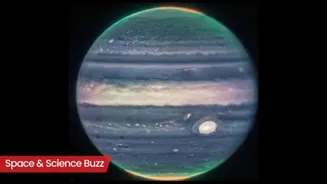Here are today’s most important updates from the realm of Science and Space.
Scientists Crack the Mystery of When Jupiter Was Born
For decades, scientists have debated exactly when Jupiter, the largest planet
in our solar system, came into being. Now, researchers have finally confirmed the timing of Jupiter’s birth. Around 4.6 billion years ago, as the young solar system formed, Jupiter’s rapid growth created enormous gravitational disturbances. These disturbances flung small rocky and icy bodies known as planetesimals into high-speed collisions. The heat from these violent impacts melted rock and dust, producing tiny molten droplets that solidified into spheres called chondrules. Today, these chondrules remain preserved in meteorites, acting like time capsules from the solar system’s earliest days.
One Cosmic Shout, Then Silence; Strongest Alien Signal Baffles Scientists

An international team of scientists has detected the strongest signal from deep space ever recorded. The Fast Radio Burst (FRB) is confirmed to have come from a galaxy some 130 million light-years away in the constellation Ursa Major. Nicknamed RBFLOAT — “Radio Brightest Flash Of All Time” — this ultrabright burst lasted just milliseconds but outshone every other radio source in its host galaxy during that fleeting moment. Fast radio bursts are intense but brief flashes of radio waves from distant galaxies, often lasting only a few milliseconds. Their origins remain largely unknown, but these bursts release as much energy in that brief instant as the Sun emits in several days.
Small but Mighty: Microbes That Could Slow Global Warming Discovered

Scientists have uncovered how two microorganisms act as natural filters, consuming methane before it escapes into the atmosphere. Methane is the second most potent greenhouse gas (GHG) after carbon dioxide, significantly driving up global temperatures. Emitted from agricultural activities, landfill waste decomposition, and fossil fuel processing and burning, methane has a far greater heat-trapping ability than carbon dioxide. The key players are anaerobic methanotrophic archaea (ANME) and sulphate-reducing bacteria (SRB). Together, they form a symbiotic relationship: ANME microbes break down methane and release electrons, which are then absorbed by SRB. The bacteria, in turn, use these electrons to generate energy, completing the cycle. Detailed understandings could also aid future strategies to meet global climate change mitigation goals.
Time Travel in Sand: Rare Jurassic Fossils Unearthed in Jaisalmer

Geologists in Rajasthan's Jaisalmer have uncovered rare vertebrate fossils from the Jurassic era, potentially including dinosaur remains, shedding new light on the region’s prehistoric ecology and biodiversity. Preliminary analysis indicates the fossils belong to a phytosaur, a crocodile-like reptile that thrived in forested areas near river ecosystems. This marks the first discovery of phytosaur fossils from Jurassic rocks in India, a significant milestone in the country’s paleontological history. The 210-million-year-old fossils, embedded in sedimentary rock formations, may also include remains of other prehistoric reptiles that inhabited the region.














